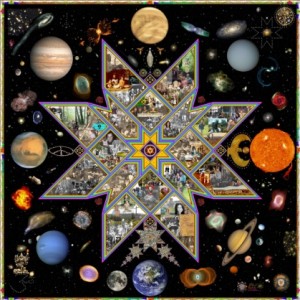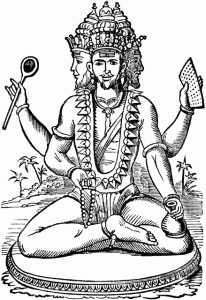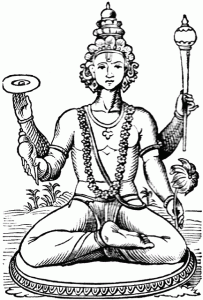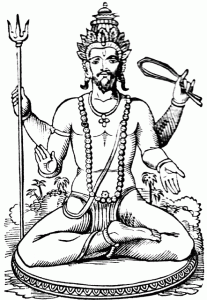To gain a clear, deep, and accurate understanding of what is actually meant and signified by the Trimurti – the Hindu Trinity – of Brahma, Vishnu, and Shiva, it is first necessary to understand the concept in Hinduism of the cyclic appearance and disappearance of the universe.
THE APPEARANCE & DISAPPEARANCE OF THE UNIVERSE
 Hinduism perceives and portrays all life as a constant, ongoing, ever evolving cycle, comprised of alternating periods of activity and inactivity…manifestation and dissolution…the “life,” “death” and “rebirth” of the universe, in other words.
Hinduism perceives and portrays all life as a constant, ongoing, ever evolving cycle, comprised of alternating periods of activity and inactivity…manifestation and dissolution…the “life,” “death” and “rebirth” of the universe, in other words.
In Sanskrit these vast periods of universal activity and inactivity are known under the terms Manvantara and Pralaya. They are also called “the Days and Nights of Brahma.” Brahma means the Universe itself and so the Days and Nights of Brahma are simply the days and nights of the universe, its cyclic appearance and disappearance. These are also referred to as the outbreathing and inbreathing, the exhalation and inhalation, of the great Divine Breath.
The reason Hinduism describes the universe and everything in it as being “maya” – illusion – is precisely this: its impermanence, its finite nature, its changeability and ultimate temporariness.
ompletely dissolved and disappeared. Only the One Supreme Reality would remain and that “Only One” is Absolute Infinite EXISTENCE Itself. It is the Great Undefinable, the Great Indescribable. This is That which is referred to as Brahman…not Brahma but Brahman. This is Who and What we really are, in our own Real Self and essential nature as pure eternal Spirit. The Hindu scriptures tell us, “You are Brahman; in the highermost part of your being you are literally one and the same as this Absolute Infinite Divine Consciousness; Brahman is all and in all!”
HOW DOES THE UNIVERSE COME INTO BEING?
Since Brahman is the Absolute, the Infinite, the Ultimate, the Unconditioned and Unmanifested, It is above and beyond all name, all form, all matter, all manifestation, and everything finite, conditioned, and differentiated, although at the same time everything matching this description is of course permeated with Brahman since Brahman is all there is.
So how does the universe come about? How does this manifested universe actually come into being seeing as Brahman is Absolute, Infinite, and Immutable and thus can have no active relation whatsoever with the finite, manifest, and mutable? This is what the great Hindu teaching about Brahma-Vishnu-Shiva explains and represents.
In the Mundaka Upanishad – which is one of the deepest, most esoteric, and most ancient of all the Upanishads – Brahman is described in the very first verse as “Infinite Godhead” and then it is taught that at the beginning of every universal cycle Brahma comes forth, springs forth, is projected, from Brahmanand that Brahma is the “evolutionary energy” which is the Universe. This important Scripture goes on to say that Brahma – the LIVING UNIVERSE – “embodies the process of evolution into name and form by which the One [Brahman] appears to be many.”
BRAHMA = TIME = THE UNIVERSE
During the period of the universal night, the Pralaya, there is no such thing as Time but only Eternity. Eternity, Infinity, is Brahman. Time (which is neither eternal nor infinite) is Brahma. So Brahma emerging – or rather, re-emerging – from Brahman is none other than TIME re-emerging from the infinite bosom of ETERNITY.
One of the symbolic names given to Brahma in some Hindu scriptures is Kala-Hansa which means the “Swan of Time,” since the Energy that is Brahma serves as the swan, the vehicle, on and through which Brahman can ride or fly into manifested expression. This “evolutionary energy” is the energy and force of Time itself, with Time being viewed here from its higher, metaphysical perspective.
In the well known designation of the Hindu Trinity –
Brahma is called the Creator.
Vishnu is called the Preserver.
Shiva is called the Destroyer.
Brahma, Vishnu, and Shiva are not three different beings or three different entities…in fact, they are not beings or entities at all…they are the three different aspects of the one all-ensouling Life of the Universe. This is very important to understand.
BRAHMA
 Brahma is that particular great Energy of evolution, of emanation, of manifestation and is the very first light which radiates forth from Brahman each time the universe comes into being, since Brahma is the Universe itself. Brahma is called the Universal Mind or Divine Mind, the Divine Universal Ideation, and all the necessary “material” for manifestation comes forth from and through Brahma at the dawn of Time. Although Brahma is popularly called the Creator, Hinduism does not actually teach creation but teaches emanation and evolution. It says that there is no such thing as “creation” since nothing new (i.e. no NEW THING) can ever be created, for only the Absolute, Infinite, Unconditioned, Attributeless ONE exists…and in fact that ONE does not actually exist (“exist” or “exists” implies something in the active process of existING)…It is pure EXISTENCE Itself. There is nothing but That.
Brahma is that particular great Energy of evolution, of emanation, of manifestation and is the very first light which radiates forth from Brahman each time the universe comes into being, since Brahma is the Universe itself. Brahma is called the Universal Mind or Divine Mind, the Divine Universal Ideation, and all the necessary “material” for manifestation comes forth from and through Brahma at the dawn of Time. Although Brahma is popularly called the Creator, Hinduism does not actually teach creation but teaches emanation and evolution. It says that there is no such thing as “creation” since nothing new (i.e. no NEW THING) can ever be created, for only the Absolute, Infinite, Unconditioned, Attributeless ONE exists…and in fact that ONE does not actually exist (“exist” or “exists” implies something in the active process of existING)…It is pure EXISTENCE Itself. There is nothing but That.
So Brahman, “Infinite Godhead,” is not a Creator, has never created anything, and can never create anything. It simply emanates Itself through Itself, within Itself, and as Itself. Emanation and evolution are realities but creation is not. And it is Brahma which is the great Evolver.
VISHNU
 Vishnu is that particular great Energy which preserves, sustains, and ensures the conservation and continuation of that which has been brought into being. Since Brahma only really has full expression in the beginning stages of the universe and Shiva only really has full expression in the closing stages of the universe – the dawn of Time and end of Time respectively – it is Vishnu which is responsible for everything in between and this “in between” period is of course by far the greatest, lengthiest, and most important period of all. This is one of the main reasons why Vishnu is generally the most celebrated, worshipped, and adored God in Hinduism.
Vishnu is that particular great Energy which preserves, sustains, and ensures the conservation and continuation of that which has been brought into being. Since Brahma only really has full expression in the beginning stages of the universe and Shiva only really has full expression in the closing stages of the universe – the dawn of Time and end of Time respectively – it is Vishnu which is responsible for everything in between and this “in between” period is of course by far the greatest, lengthiest, and most important period of all. This is one of the main reasons why Vishnu is generally the most celebrated, worshipped, and adored God in Hinduism.
“Vishnu” literally means “The All-Pervading One” and is also referred to asMaha-Vishnu meaning “The Great Vishnu” or “Great All-Pervading One” and Narayana, “the Spirit of Divine Ideation who moves upon the waters of Cosmic Space.”
As we said earlier, Brahma, Vishnu, and Shiva are not three different beings but are the three different aspects of the one all-ensouling Life of the Universe. Vishnu is often presented and portrayed in Hinduism as the overall personification of that one Universal Lord, the Lord and Life of the Universe. At the same time, other branches of Hinduism prefer to present and portray Shiva as the overall personification of “Ishvara,” the Lord. There is really no contradiction or serious discrepancy because Brahma-Vishnu-Shiva is not three but is ONE, manifesting in three different ways at three different times. It is entirely a matter of personal choice and preference as to whether an individual refers to the all-ensouling Life of the Universe as Vishnu or as Shiva or as Brahma. A Trinity is one in three and three in one.
Bearing this in mind, we won’t be surprised or confused when we read in scriptures such as the Purusha Suktam that Vishnu (who is generally considered to be the one referred to in this ancient text) “pervades all the universe yet still extends ten inches beyond” and that only ¼ of himself has become the material manifested universe (i.e. immanent) with the remainder remaining pure, unsullied, and transcendent or the famous declaration by Krishna (who is considered in Hinduism to be the greatest Avatar of Vishnu) in the Bhagavad Gita that “Having pervaded this entire universe with but a fragment of Myself, I remain.”
Elsewhere in the Bhagavad Gita, Krishna – presumed to be speaking as Vishnu– states that the seven “Mind-Born Sons of Brahma” were born from his(Vishnu’s) mind and other Hindu scriptures state that these seven “Sons of the Universal Mind,” also called the Seven Kumaras, were born from Shiva by Brahma. There is really no contradiction because the three are all one and Krishna clearly identifies himself in the Bhagavad Gita not just with Vishnu the Preserver but with Brahma-Vishnu-Shiva…the Lord and Life of the Universe.
SHIVA
 Shiva is that particular great Energy which comes into full force at the end of the Day of Brahma, the end of the Maha-Manvantara, the end of the Universal Cycle, the life span of the universe being said to be a period of 311,040,000,000,000 years. Shiva is the force of culmination, completion, finalisation, dissolution, disintegration, and destruction but this is not a negative or bad role to play…it is an absolute necessity in order to bring about the end of the universe and its subsequent disappearance and absolute reabsorption into Brahman until the next Universal Cycle after a period of rest and inactivity of the same duration as the period of activity, namely the utterly inconceivable 311,040,000,000,000 years.
Shiva is that particular great Energy which comes into full force at the end of the Day of Brahma, the end of the Maha-Manvantara, the end of the Universal Cycle, the life span of the universe being said to be a period of 311,040,000,000,000 years. Shiva is the force of culmination, completion, finalisation, dissolution, disintegration, and destruction but this is not a negative or bad role to play…it is an absolute necessity in order to bring about the end of the universe and its subsequent disappearance and absolute reabsorption into Brahman until the next Universal Cycle after a period of rest and inactivity of the same duration as the period of activity, namely the utterly inconceivable 311,040,000,000,000 years.
Some people think of Shiva not only as the Destroyer but also as the Regenerator because the task of universal dissolution and destruction enables the universe to be reborn at a higher and greater level of evolution when the Great Pralaya eventually comes to an end. It is for this and other reasons that Shiva is given the title of “Mahadeva,” meaning “Great God” or “Superior Deity.”
LET’S NOT TRY TO HUMANISE THE DIVINE
We’ve included pictures of Brahma, Vishnu, and Shiva in this article because it’s interesting and worthwhile to see how they are portrayed and symbolised in an anthropomorphic sense in Hindu religious artwork (there is profound symbolic meaning to all the intricacies and details of Hindu religious art) but at the same time we’ve avoided referring to them in an anthropomorphic way throughout the article because a clear and accurate understanding of the matter cannot be gained as long as we try to drag the spiritual and divine down to the human level.
Brahma, Vishnu, and Shiva are not three individual anthropomorphic beings holding sway in the heavenly realms like three big governors of the Universe; they are the three different aspects of the one all-ensouling Life of the Universe. This “Life of the Universe” is the LIVING UNIVERSE itself, in its higher and metaphysical dimensions.
Not a threefold Person but a threefold Principle, the Trimurti of Brahma-Vishnu-Shiva radiates forth from Brahman and from Brahma-Vishnu-Shiva emanates the entire manifested universe. The Chandogya Upanishad puts it like this…
“This universe comes forth from Brahman, exists in Brahman, and will return to Brahman. Verily, all is Brahman.”
“In the beginning was only Being, ONE without a second. Out of Himself He brought forth the cosmos and entered into everything in it. There is nothing that does not come from Him. Of everything He is the inmost Self. He is the truth; He is the Self supreme. You are That, my son, you are That.”
~ SecretDoctrine











